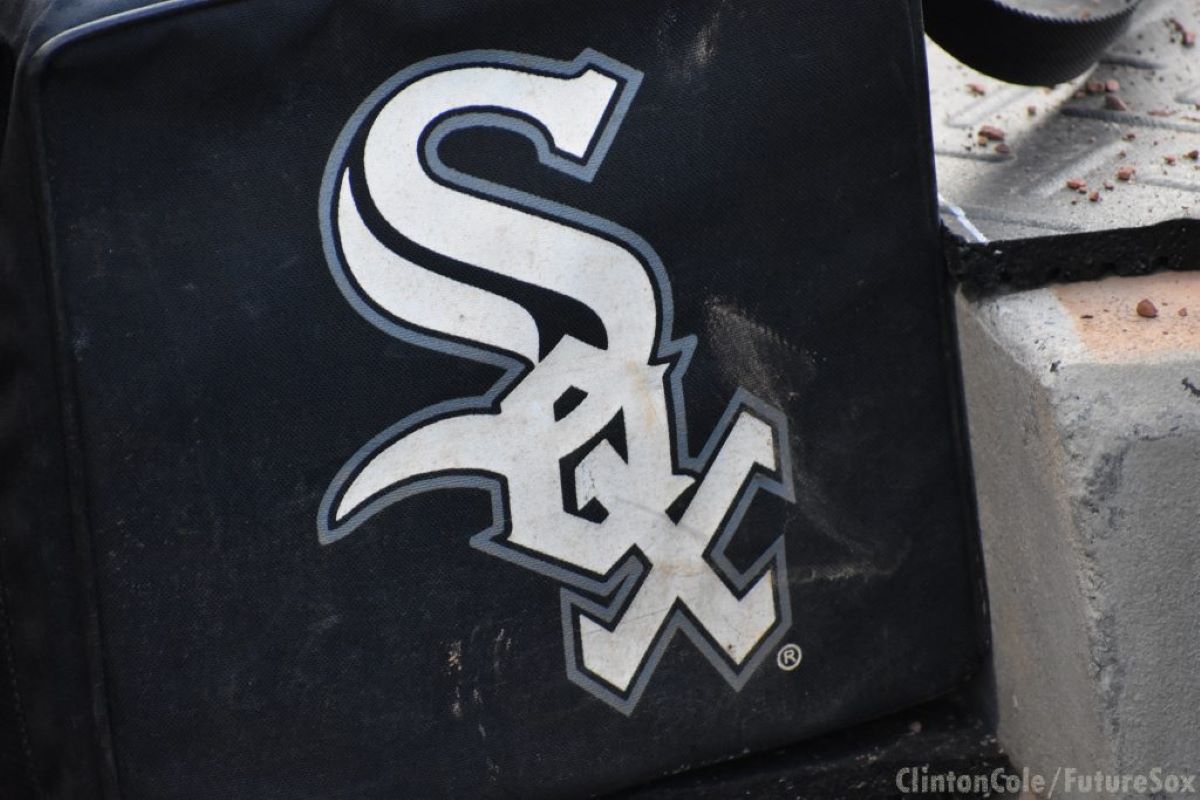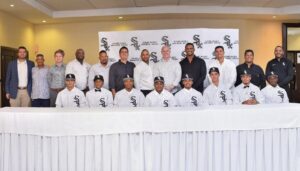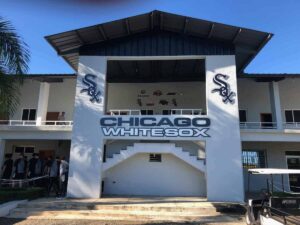White Sox acquire two young pitchers for international bonus pool space

Photo via Clinton Cole
Sharing a spring training complex with one of the deepest organizations in the major leagues can have its perks at times. The Chicago White Sox know the Los Angeles Dodgers’ farm system better than others due to the shared usage of Camelback Ranch as a facility and spring training home in Glendale, Arizona. The two clubs also hammered out an agreement that sent veteran righties Lance Lynn and Joe Kelly to Los Angeles prior to this year’s deadline and I’m sure other names were exchanged with even more players discussed.
On Friday afternoon, the White Sox and Dodgers hooked up on a different type of transaction but more talent has once again been added to the system that took the biggest jump at this year’s deadline according to Jim Callis of MLB Pipeline. Martínez and Batista are varying levels of interesting at the moment. Both were pitching in the Arizona Complex League with the Los Angeles affiliate but Batista was recently promoted to Low-A.
Máximo Martínez is a 19-year-old righty who signed with the Dodgers out of Venezuela back in 2021. The 6-2, 185 pounder debuted in the Dominican Summer League shortly after. He was shutdown with an arm injury after throwing just four innings in the Arizona Complex League last season however. The right hander is back this year though and he accumulated 28 strikeouts in 26.2 innings but he’s also walked 17 hitters and posted a 4.73 ERA.
Eric Longenhagen of Fangraphs listed the Venezuelan as the 31st overall prospect in a really deep system in the pre-season. His fastball has jumped into the 95-98 mph range which was surprising as he profiled to be more of a polished, pitchability type. He was the youngest player who participated in the Dodgers’ instructional league back in 2021 as noted by Longenhagen. As a strike-thrower without huge life on the fastball, his secondary offerings must improve. His breaking ball has flashed plus but not consistently.
Martínez has shown a repeatable and compact delivery and it appears that the White Sox will leave him in the Arizona Complex League to continue working for now. Batista is a 20-year-old Dominican signed back in 2021 that has made his stateside debut in a big way this year. The 6-2 185 pounder was solid in the Dominican Summer League last year with a 1.55 ERA in 40 innings pitched. In 39 innings in the Arizona Complex League so far this season, the righty has posted a 3.46 ERA while averaging 12.46 K/9 and 3.46 BB/9.
Batista is leading the ACL in strikeouts with 54 overall in his 39 innings. Baseball America noted that the 20-year-old is an “up arrow prospect hidden in the depth of the Los Angeles’ system” in their trade write-up. He’s shown a low 90’s sinker that has touched 97 mph and he displays a low 80’s slider with an inconsistent changeup as well. Both pitchers have been added to the rookie level roster for the White Sox’s affiliate in the Arizona Complex League. Batista was named as the player of the month for Minor League Baseball in the ACL for July as well.
The White Sox have traded international signing pool space before but this type of deal brings back actual upside instead of dumping a finite resource to line the pockets of ownership. It still allows for skepticism on the outside though due to the perception of a flawed strategy in the international marketplace by Marco Paddy and the rest of the decision makers. As of mid-June, the White Sox still had well over $1 million remaining in international pool space according to Francys Romero and that’s the most money available of any club.
The White Sox began the process with a total of $5,284,000 to spend. They used close to $4 million on prospects comprising their current Dominican Summer League roster. Their signing class consisted of more than 20 players and was highlighted by Dominican outfielder Abraham Núñez Jr and right hander Luis Reyes. Reyes is starting to figure things out and Núñez has been one of the better players in the league with on base skills and hitting ability on display that has led to a wRC+ of 138. It was just assumed that the remaining $1.4 million was being earmarked for another signing; likely a Cuban player who entered the fray later into the process.
It’s unclear how much of the $1.4 million that the White Sox had remaining will be sent to the Los Angeles Dodgers in this exchange. The signing period will end on December 15, 2023. Due to free agent additions and a payroll over the luxury tax threshold, the Dodgers came into the signing period with just $4,144,000 to spend; the lowest of any club during this current international period. They might need the money to pay their outstanding commitments within the class or they could use it to sign another player that has become available to them in some way.
The White Sox landed two more intriguing pitching prospects and they’re both really far away from contributing. This is a smart move for the organization to snag two live arms while allowing the Dodgers to spend more of their own money. It remains puzzling however that the White Sox, led by a well respected international boss like Marco Paddy often find themselves in the position of not having deals previously agreed upon with top players from the international market. This could be a totally fine outcome but the process to get here is questionable for an organization that hasn’t earned the benefit of the doubt in recent years.






Thanks, James. You covered all the bases here. Both prospects seem interesting, and this isn’t like giving away pool money just to get rid of Nate Jones, but it still feels like the Sox are too cheap to go out and scout / close deals internationally so they’re relying on the Dodgers to do it for them.
Thanks, James. You covered all the bases here. Both prospects seem interesting, and this isn’t like giving away pool money just to get rid of Nate Jones, but it still feels like the Sox are too cheap to go out and scout / close deals internationally so they’re relying on the Dodgers to do it for them.
Those players seem like they could be something. Still, I’d be interested to know the amount the White Sox sent and what the Dodgers do with it.
What the Dodgers think is they can do more with that money than the 2 they traded away. I also suspect that those 2 are given more favorable ratings because of the system they were in.
But hey who knows, maybe blind luck is on our side today.
We also may begin hearing more about the Domestic Reserve List and its impact on the minors. I believe the number is being reduced to 165 per organization in ’24. A deep organization like the Dodgers may see value to moving some guys out.
I hadn’t heard about that, I’ll have to read up on it.
My point was that a good org like the Dodgers knows who to keep and who to get rid of. Sometimes you get lucky and they make as mistake but don’t hold your breath.
Those players seem like they could be something. Still, I’d be interested to know the amount the White Sox sent and what the Dodgers do with it.
What the Dodgers think is they can do more with that money than the 2 they traded away. I also suspect that those 2 are given more favorable ratings because of the system they were in.
But hey who knows, maybe blind luck is on our side today.
We also may begin hearing more about the Domestic Reserve List and its impact on the minors. I believe the number is being reduced to 165 per organization in ’24. A deep organization like the Dodgers may see value to moving some guys out.
I hadn’t heard about that, I’ll have to read up on it.
My point was that a good org like the Dodgers knows who to keep and who to get rid of. Sometimes you get lucky and they make as mistake but don’t hold your breath.
“Well we’re terrible at signing these guys… we’ll just pay you to do it for us.”
They aren’t even actually paying them.
“Well we’re terrible at signing these guys… we’ll just pay you to do it for us.”
They aren’t even actually paying them.
Sox also got Honeywell from Padres (waivers)
Sox also got Honeywell from Padres (waivers)
Players seem OK but how many years in? Don’t they just have 5 years? Did the Dodgers maybe gave up on them because of 40 man issues in the future? They might want to play younger players with more time?
If they end up being good players, all the better, but would rather do like the Astros and get 19 – 20 year old pitchers who developed later and sign them.
Maybe start signed older pitchers and start them in the complex league since the pay is a little better now. Give them some extra bonus to cover the taxes and move them up faster. Instead of $!50K give them $200K with the agreement to start them at the complex league?
Players seem OK but how many years in? Don’t they just have 5 years? Did the Dodgers maybe gave up on them because of 40 man issues in the future? They might want to play younger players with more time?
If they end up being good players, all the better, but would rather do like the Astros and get 19 – 20 year old pitchers who developed later and sign them.
Maybe start signed older pitchers and start them in the complex league since the pay is a little better now. Give them some extra bonus to cover the taxes and move them up faster. Instead of $!50K give them $200K with the agreement to start them at the complex league?